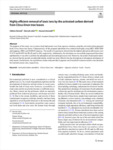

PARTNER
검증된 파트너 제휴사 자료
Highly efficient removal of toxic ions by the activated carbon derived from Citrus limon tree leaves
방대한 850만건의 자료 중 주제별로 만들수 있는 최적의 산출물을 해피 캠퍼스에서 체험 하세요 전문가의 지식과 인사이트를 활용하여 쉽고 폭넓게 이해하고 적용할수 있는 기회를 놓치지 마세요
13 페이지
최초등록일 2023.05.08
최종저작일
2021.06

-
 * 본 문서는 배포용으로 복사 및 편집이 불가합니다.
* 본 문서는 배포용으로 복사 및 편집이 불가합니다.
미리보기
서지정보
· 발행기관 : 한국탄소학회
· 수록지 정보 : Carbon letters
· 저자명 : Fahime Nemati, Dariush Jafari, Hossein Esmaeili
목차
Abstract
1 Introduction
2 Materials and methods
2.1 Chemicals
2.2 Preparation of stock solution
2.3 Preparation of adsorbent
2.4 Experimental procedure
3 Results and discussion
3.1 Adsorbent characterizations
3.2 Effect of solution pH
3.3 Effect of adsorbent dosage
3.4 Effect of ions initial concentration
3.5 Effects of contact time and temperature
3.6 Desorption and regeneration experiments
3.7 Adsorption isotherms
3.8 Kinetic study
3.9 Thermodynamic study
4 Conclusion
References영어초록
The purpose of this study was to remove lead and arsenic ions from aqueous solutions using the activated carbon prepared from Citrus limon tree leaves. Characteristics of the prepared adsorbent were studied thoroughly using BET, SEM, EDS and mapping, XRD, and RAMAN analyses. The results of experiments showed that the highest adsorption efficiencies were 97.67% and 95.89% for Pb (II) and As (III), respectively. Additionally, the adsorbent was successfully regenerated four times and therefore it was able to perform the adsorption and desorption processes well. Moreover, the results of adsorption kinetics showed that the pseudo second-order kinetic model was more effective for the description of adsorption mechanism of both metals. Furthermore, the equilibrium studies indicated that Langmuir and Freundlich isotherm models were desirable for lead and arsenic ions, respectively.참고자료
· 없음태그
-
자료후기
-
자주묻는질문의 답변을 확인해 주세요

꼭 알아주세요
-
본 학술논문은 (주)코리아스칼라와 각 학회간에 저작권계약이 체결된 것으로 AgentSoft가 제공 하고 있습니다.
본 저작물을 불법적으로 이용시는 법적인 제재가 가해질 수 있습니다. -
해피캠퍼스는 구매자와 판매자 모두가 만족하는 서비스가 되도록 노력하고 있으며, 아래의 4가지 자료환불 조건을 꼭 확인해주시기 바랍니다.
파일오류 중복자료 저작권 없음 설명과 실제 내용 불일치 파일의 다운로드가 제대로 되지 않거나 파일형식에 맞는 프로그램으로 정상 작동하지 않는 경우 다른 자료와 70% 이상 내용이 일치하는 경우 (중복임을 확인할 수 있는 근거 필요함) 인터넷의 다른 사이트, 연구기관, 학교, 서적 등의 자료를 도용한 경우 자료의 설명과 실제 자료의 내용이 일치하지 않는 경우
“Carbon letters”의 다른 논문도 확인해 보세요!
-
Concentration‑dependent emission of nitrogen‑doped carbon dots and its.. 14 페이지
-
A study on the machinability of advanced arc PVD AlCrN‑coated tungsten.. 11 페이지
-
Sensing behavior of Cu‑embedded C3N monolayer upon dissolved gases in .. 8 페이지
-
Structural and electronic properties of 2D‑activated carbon sheet 6 페이지
-
Vertically aligned carbon nanotubes‑coated aluminium foil as flexible .. 9 페이지
문서 초안을 생성해주는 EasyAI

